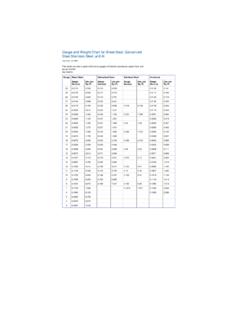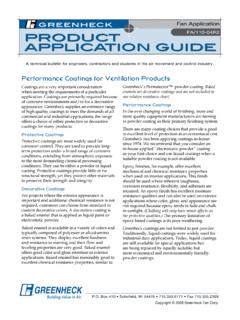Transcription of Fan Application product application guide
1 The air moving industry uses a common term todescribe certain inlet and outlet conditions thatadversely affect fan performance. The term used is"system effect". Perhaps the term should be "faninstallation effect", because system effect resultsfrom the difference in how the fan was tested,compared to how it is installed. To minimize systemeffects, air must enter or leave a fan let s take a look at how fans are tested andcataloged. Most fans available in today s marketbear AMCA Certified Rating Seals. This means thatthe fan manufacturer followed the test proceduresas outlined in AMCA Publication 210 and tested thefan in one of the standardized configurationsapproved by AMCA. One of the requirements ofAMCA, is that directly under the catalogedperformance for a given fan model, the fanmanufacturer must make a statement as to how thatproduct was tested. Paying attention to thesestatements is the first step in avoiding system statements for three different product typesare:Roof exhaust fans: Performance shown is forInstallation Type A: Free inlet, Free outlet.
2 Powerrating (BHP) does not include drive ratings do not include the effects ofappurtenances in the axial fans: Performance shown is forInstallation Type B: Free inlet, ducted outlet. Powerrating (BHP) does not include drive ratings do not include the effects ofappurtenances in the fans: Performance shown is forInstallation Type B: Free inlet, ducted outlet. Powerrating (BHP) does not include drive ratings do not include the effects ofappurtenances in the airstream. It is important to realize that fan manufacturers canonly guarantee the fan to perform as tested. In theexamples shown, not one of the fans were testedwith obstructions, such as elbows, guards ordampers, directly at the fan inlet or outlet. Theseobstructions cause additional losses that are notincluded in the fan manufacturer s tests, and inmany cases, are not included in the designers' usualsystem resistance calculations.
3 Most designers arewell trained in determining the resistance thatoccurs in the system s ducts, filters, dampers andelbows that are located some distance from the fan,but they pay little attention to obstructions near thefan. The interaction of the air and the obstructionjust prior to the fan causes the additional lossesknown as system following figures illustrate how fans are testedin comparison to how they are sometimes installed. Roof Exhaust FansFigure 1 illustrates how roof exhausters are vertical straight duct would have little ifany effect. Figures 2 and 3 illustrate roof exhaust faninstallations having system effects. Figure 3illustrates the worst case, because the damper islocated in a turbulent airstream. To improve oninstallations where horizontal ducts are useddirectly under the roof line, turning vanes should beinstalled in the elbows. Inaddition, a higher curb orextended base should beused.
4 Higher curbs result inthe elbow being further fromthe damper and fan inlet. Understanding Fan System EffectsFig. 1 Figure 1 is typical of how roof exhausters aretested. AMCA Publication refers to this setup as "Type A: Free inlet, free outlet." Box 410 Schofield, WI 54476 Fax Application guide A technical bulletin for engineers, contractors and students in the air movement and control Application Copyright 1999 greenheck Fan Fan Application No. FA/101-99 greenheck product Application GuidePoorPoorFig. 3 Fig. 4 Fig. 5 Figure 2 illustrates a poorinstallation with horizontal ductand an abrupt elbow at the faninlet causing system 3 illustrates the sameinstallation as Figure 2 withthe addition of a dampercausing even greater 4 is typical of how tube axial fans are tested. AMCA refers tothis set-up as "Type B: Free inlet, ducted outlet." Tube Axial FansFigure 4 illustrates how tube axial fans are with straight inlet ducts and inlet bellswould result in similar performance.
5 Without adischarge duct, a system effect will occur. (See figure12 on page 4 for recommended discharge.) Inlineinstallations are subject to system effect both at the faninlet and outlet, as shown in Figures 5 and 6. Figure 5illustrates a poor inlet condition with an elbowdirectly at the fan inlet. Figure 6 illustrates a pooroutlet condition where the fan discharges too close toa wall. Inline fans require the appropriate length ofdischarge duct in order to achieve catalogedperformance. (Refer to figure 12 on page 4.)Fig 6 Fig. 6 Figure 6 illustrates a poor installation withthe fan located to close too a 2 Figure 5 illustrates a poor installationwith an elbow directly at the fan air entering the fan is forced toone FansFigure 7 illustrates how housed centrifugal fansare tested. Centrifugal fan installations are subjectto the greatest possibilities of system effect due tothe possibilities of both ducted inlets and outlets,plus multiple available arrangements, dischargepositions, and CW or CCW rotations.
6 Figure 8aillustrates a poor installation with an elbowdirectly at the fan discharge. This type ofinstallation can be avoided by selecting a fan withthe correct rotation and discharge position asshown in figure 8b. Figure 9 illustrates anotherpoor installation with an abrupt discharge into aplenum. A system effect results if a given lengthof discharge duct is not present. (See figure 12 onpage 4 for recommended discharge ductwork.)Both figures 10 and 11 illustrate installation withimproper inlet conditions. Figure 10 could beimproved with at least one fan wheel diameter ofstraight duct between the fan and the as shown in figure 11 should beavoided if possible because the effect of inlet spinis difficult to define and Fan Application No. FA/101-99 Fig. 8aFig. 7 Fig. 9 Figure 7 is typical of how centrifugalfans are tested. AMCA refers to thisset up as "Type B: free inlet, ductedoutlet.
7 " Figure 8a illustrates a poorinstallation with an elbowdirectly at the fan discharge. Figure 9 illustrates a poor installationwith an abrupt discharge into a plenum. Fig. 10 RotationFig. 11 Figure 10 illustrates apoor installation withan elbow directly atthe fan inlet. Figure 11 illustrates apoor installation wherethe duct design iscausing inlet spin,resulting in reduced previous illustrations show only a few of themany installation possibilities that can causesystem effect. Remember different types of fans aresubject to different considerations based on howthey were tested. AMCA Publication 210 showsfour basic installation types. However, combiningall the fan types, fan arrangements, andmanufacturer s choice of how to test, theinstallation possibilities are far too numerous tocover in this article. What type of fans are affected by what conditionand what condition presents the most commonproblems?
8 Roof exhaust fans are affected by the inletcondition. Roof supply fans are affected by outletconditions. Fan types typically affected by both inlet andoutlet conditions are inline fans (both axial andcentrifugal) and housed single inlet product Application GuideFig. 8bFigure 8b illustrates a typicalinstallation with an elbow directly at thefan discharge. Discharge and rotationhave been selected to match the fans fieldconditions of figure Fan Application No. FA/101-99 greenheck product Application GuideFan installations with system effects should beavoided if possible. However, in many cases spaceconstraints or other factors prohibit designers toallow for ideal following conditions (listed by inlet and outlet)cover the most common causes of system Conditions: elbows too close to fan inlet abrupt duct transition inlet spin due to duct design dampers not fully open damper locations poorly designed guards inlet too close to walls or bulkhead inlet boxesOutlet conditions elbows too close to fan outlet abrupt transitions free discharge damper location weatherhoods discharge guards discharge too close to wall or bulkheadThe following recommendations will help inavoiding installation problems: Understand how the fan you selected was tested.
9 (Refer to the catalog statements under the fansmanufacturer s performance tables.) For roof mounted fans where the duct must runhorizontal directly under the roof, install turningvanes in the elbow, plus consider using higher curbsor extended bases. This additional height willincrease the distance from duct elbows and dampersin relation to the fan inlet. Consider different types of fans. For instance, ifthe duct must turn 90 , a centrifugal fan installed inthe turn could be a better choice than an inline fanwith an abrupt duct elbow. Select housed centrifugal fans with the properrotation and best discharge position for thesituation. If an elbow is required at a fan inlet due to spaceconstraints, use an inlet box that has a predicted lossin lieu of the elbow. Avoid free discharges for inline and centrifugalfans. Add the duct length required to obtain auniform velocity profile and to minimize losses (seefigure 12).
10 Blast AreaDischargeDuctOutletArea25%50%75%100% Effective Duct LengthCutoffFig. 12 Figure 12 illustrates the need to use astraight duct length on the discharge ofboth inline and centrifugal fans. In orderto achieve a uniform velocity profile, a100% effective duct length must be calculate the 100% effective length,use duct diameters for 2500 FPM (orless). Add one duct diameter for eachadditional 1000 's understandable that in many cases aninstallation will end up having obstruction at theinlet or outlet (or both) causing system effect. Ifthese situations cannot be avoided at the designstage, the system effect should be estimated andadded to the calculated system resistance. Keep inmind that the standard procedures for the design ofduct systems are all based on the assumptions ofuniform flow profiles in the system. The standardadds for resistance of elbows does not account forthe loss when the elbow is close to the fan.


